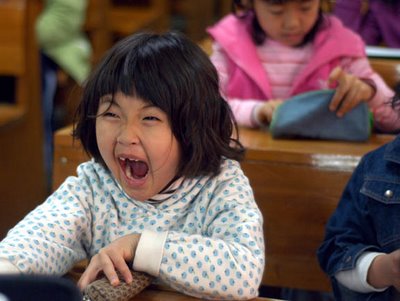
During the auditorium classes we taught about insects last week. Nothing drew a bigger response than the photos of the spider, centipede and cockroach. You could hear the classes yelling their heads off all the way in the teacher's lounge.
For the first (and probably only) time in SoKoNotes history, I want you to stop what you are doing and redirect your browser somewhere else...To my brand new website (you can always come back). Click the following link:
Stephen Jones Photography
Click on the "Explore the Site" link, sit back, relax and take a tour of the Appalachian Trail or experience picturesque Hattiesburg, Mississippi. Weird word, 'picturesque.' Weird place, Hattiesburg. I have spent the last three months building the pages from scratch using a program called Adobe GoLive. I had a lot of help from Gavin, who taught me how to operate the program. He also showed me the main strength of GoLive: The ability to seamlessly integrate Photoshop files using SmartObjects. Photoshop is a program I am much more familiar with, and it made laying my pages out much easier. I also had a "For Dummies" book on GoLive courtesy of my parents, and it came in handy when the time came to upload my site to the server. A marvelous book. My deepest thanks to my parents and Gavin.
Now back to the blog.
I think it's funny how some children grow faster than others. In some of my classes, particularly my fifth and sixth graders, there is a student or students who are measurably larger than their peers. The children in these classes are between eleven and thirteen, at the threshold of puberty, and the ole' mother nature has decided it's time they become adults.
Take Ho-jeong, for example. I taught her for two months last semester as a fifth-grader. At twelve years old, she was not the oldest child in the group, but Ho-jeong stood a solid foot taller than the second-tallest child in 5A. When I first took the class, I thought for a second that perhaps Ho-jeong was a middle-school student who got her classroom mixed up. When the children all stood up every day to greet me, Ho-jeong looked like Gulliver among the Lilliputians. When she walked down the halls with her friends, one could have easily mistaken her for their "Ohni," older sister.
What really threw me was Ho-jeong's behavior. My natural inclination towards Ho-jeong was to treat her like one of the older children, and I unconsciencely expected more from her than her classmates. For one thing, she was the smartest student in the class. Her hand would rocket into the air after every question, her eyes bulging, a plaintive look on her face.
"Mr. Jones! Mr. Jones! I know it! I know the answer! Verb! VERRRB!"
I assumed she was equally mature. This turned out to be wrong-headed. Make no mistake, Ho-jeong was the sharpest knife in the drawer, and her genetic code was way ahead of the curve, but psychologically speaking she was still a child. She would play with the other children before class, towering over even the boys as they drew goofy faces, monsters and princesses in the chalk dusk adhered to the blackboard. Only Ho-jeong could draw high up on the blackboard where the other children couldn't reach. She would laugh as they jumped up and tried to erase her doodles.
There are other tall fifth and sixth-graders in my other classes. Seong-leong of my current 6A class , who is all of twelve years old himself, is as tall and almost as broad at the chest as I am. Ah-hyun of Advanced 4-1 is taller than Ho-jeong; however, Ah-hyun possesses a much more reserved personality.
The opposite can be true, too. I have children in my upper-level middle-school classes that could easily blend into a lower classes. The smallest of these late-bloomers tend to act out more than their fully-developed peers, as if trying to make up for their small size with the volume of their voice.
If I had to pick a favorite age group, I would not hesitate to pick the sixth-graders. They are still young enough to possess a great deal of enthusiasm for learning and they have the cognitive complexity to engage in some of my most fun, creative activities. If I had to pick a second favorite group of students, I'd pick the youngest students. Pound-for-pound, no other group of children exhibits more energy, vitality and honest enthusiasm than a pack of first and second-graders. This is Jeong-yoon, a child truly like no other.
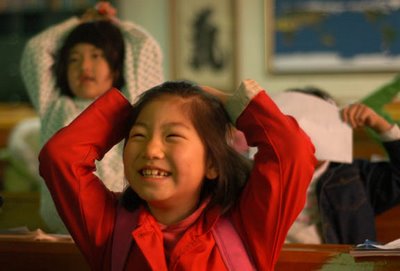
The raucous, joyful sound of Jeong-yoon's laughter filters into the teacher's lounge all the way from the third floor around 2PM every Monday, Tuesday and Wednesday, heralding my first class of the day. Gavin, Dave or I have only to step into the same room as Jeong-yoon and she begins gushing with laughter. Her English ability is tops, too. When we started the new semester, Jeong-yoon took the new boys under her wing, guiding them through the auditorium class on Friday.
Some nights as we walk to dinner, particularly after a good day, Gavin will remark in his deep, no-bullshit tone, "I really like our kids."
Me too.
What's so funny to me is how before I came to Korea children were, in many respects, a mystery. In some ways, my job as a newspaper photographer well-prepared me for interacting with children, as many of my assignments centered around gathering images of cute children doing cute things so people who are suckers for anything cute would buy the paper.
My sporadic contact with children in Hattiesburg couldn't prepare me for the benefits of those interactions. I had no idea that teaching could be so rewarding. Nothing makes me feel as great as the honest 'hello' and a smile from a passing pupil. The act of teaching alone forces one to build a relationship with the children so one can understand what and how they need to learn. This simple act of caring for another person is healing in of itself, a balm for the wounds inflicted by life in the real world. Teaching has helped me to grow and mature, face fears and solve problems.
* * *
The ESS staff went on a 'picnic' last weekend. I don't know many picnics that start at 6AM, last all day, and involve driving by bus all the way to the other side of the country. Most of my picnics involve a local park, a cloth, a bottle of wine and some food.
This was a balls-out road trip.
Mr. Kim rented a big orange tour bus. Just as I expected, somebody neglected to install an aircraft-style lavatory in the rear (a la most of the tour buses I have encountered in the United States). In preparation for just such a lapse in judgment, and still carrying the scars from the embarrassing pissing episode on the bus to Gyeong-ju during last fall's Chuseok holiday, I left my water bottle at home.
Most of the teachers were there, casually dressed, which is something of a shock when one is used to strait lines and high-heels all the time. Soo-hyun wore light blue jeans with a tear in them. Soo-hee cut the glare with a pink baseball cap. Even the normally exquisitly-dressed, ultra-professional Ms. Ha sported jeans, a t-shirt and a big smile. One of my favorite ESS personalities, Bok-shim, was there too.
Bok-shim is a stout, good-natured ajumma no taller than my shoulder with a confidant, pugnacious swagger and a gentle wit. Often times she can be found in the third-floor lobby chatting up the receptionists and scolding the children, a mop in her left hand and her right hand stuck in her jacket like Napoleon Bonaparte. She always wears a little bling: A watch or a ring encrusted with gold and jewels, though it's her warm smile and friendly nature that makes Bok-shim really stand out.
On Saturday she strutted onto the bus with a giant purple gem around her finger and the frames of her glasses so ornate they looked like they had been made in Rivendell.
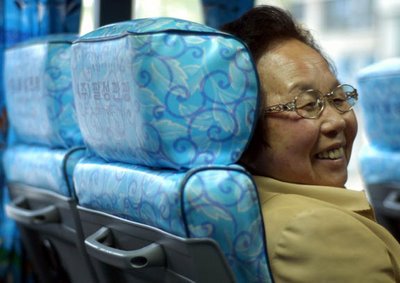
The bus shuddered to life as the driver dropped it into gear and off we went to the provence of Hye-nam, the hometown of Na-ri and a five hour journey to the opposite side of the Korean peninsula. Gavin and I quickly fell asleep to the soothing clucking of the Korean women chatting a few seats up.
The first place our bus visited was, ironically, a rest stop. Having had deprived myself of water in anticipation of a torturously long journey, I looked on from the bus as my better-hydrated companions disembarked and relieved themselves. At the onset of the trip Mrs. Kim had provided a grocery bag filled with goodies like candy, cookies and fruit to all in attendance. I snacked on "tok," cinnamon-honey sandwiches and wasabi-encrusted peas while waiting for the bus to get moving again.
Food was really the highlight of the day, but more on that later.
Our second stop was a traditional Korean village in the style of the 14-1500s, carefully preserved by the Korean government, perhaps to remind people of their history and heritage. A thick (my eyes put it at ten feet) stone wall fifteen feet high encircled the entire town, and it was upon this battlement that we began our tour.
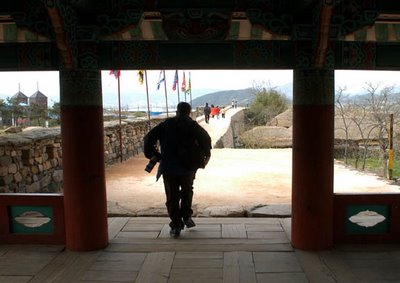
The high wall gave us a splendid view of the town within. Uncomplicated thatch-huts and tiny farm plots dotted with chickens dominated the scene. Tourists in brightly-colored parkas and nylon sweatsuits walked among the soft earthen-toned structures, taking photos and pointing. In their vivid clothing, they looked to me like blooming flowers in a pile of hay.
Some of the huts were occupied, and some of the plots were alive with spring crops. People live here still, apparently. I could see their laundry drying on lines strung up between huts, and some of them were out and about, tending to their business.
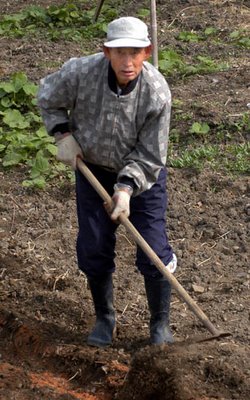
The farmer had old, bloodshot eyes and a face that said nothing. I felt sort of odd as I walked on the wall high above him, like I was invading his home. I wondered if in five-hundred years this village will still be here, or if maybe there will be another "traditional Korean village" made to look like Dongsamjugong: A skyscraper full of villagers, a quickie mart and a PC Bong.
At one end of the wall was a hill, and the wall rose abruptly to its summit. Mr. Yi took the lead up this stoney embankment.
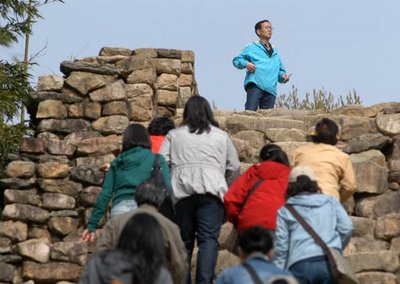
After touring the museum, we came to the ancient village police hall. Within were a few plastic "prisoners" and their "accusers." They were in cheesy, dramatic poses of agony or penitence. The Korean staff chuckled and took photos of the permanently apologetic criminal.

Our next stop was at the home of a famous Korean scholar named Gosun Yun Sun-do, reputed to be "one of the greatest writers in Korean history," according to the plaque at the entrance to his ancient ancestral home. Gosun, who lived from 1587 to 1671, got in a lot of trouble for pointing out the corruption of the oppressive Korean government officials in power. he was exiled, twice, and pardoned, twice. During his exile(s), he wrote poems about his "mountain fastness" in Hye-nam. I likened him to a Korean Thoreau, although Henry exiled himself versus getting the boot from corrupt government officials a la Yun Sun-do.
A giant, five-hundred year old tree stood in the courtyard of his home, the only living thing to have shared it's existence with the outspoken poet. The teachers took pictures. Mr. Kim's son Byeong-su played with a dog. I practiced reading Hangul, drawing quite a few "oooohs" and "ahhhhs" and encouragement from the staff. Afterwards, it was time for lunch.
The only highlight from lunch was the Makalli. I was frankly surprised when the waitress brought out the brown earthen bowl filled with milky-white, 25% alcohol-conent rice liquor. Drinking with my boss was not on the agenda, and Gavin and I were reticent to sacrifice any inhibition. We drank a bowl or two. The Korean teachers seemed even more apprehensive, and many didn't finish the drinks.
After lunch we went to a huge Buddhist temple.

The problem with bus tours is that one never gets enough time to properly explore such sites. Dozens of structures, courtyards and pagodas were there to be explored, but we only had thirty minutes or so before we had to return to the bus. On the way back I stopped at a trinket shop to see if they had any flashing-Buddha keychains (many temples do) and I came across this man and his son in some nice window light. It must be odd, cosmically speaking, when a tourist photographs another tourist in a trinket shop.
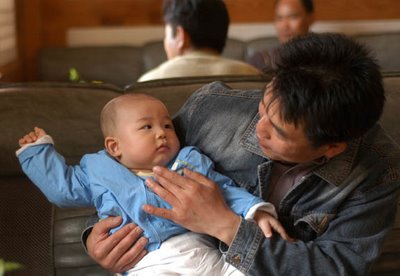
After a long ride, the bus took us to our final destination: Tangkeut, The End of Korea. Unless you put on a bathing suit or jumped in a boat, you could not go any further south on the peninsula than here, and the people of Hye-nam were proud of this. They even erected a sleek metal tower at the site's summit so you could look out over the sea.
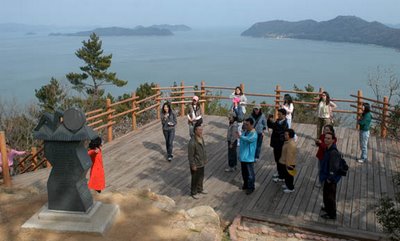
We took photos from a platform overlooking the tiny islands surrounding Tangkeut.

As we walked down to take a piss, Na-ri told me that there had been a curse on the men's bathroom at Tangkeut. It was rumored that people who pissed within died soon thereafter. As I took my place among all the dead men at the urinals, I wondered how I would meet my untimely demise. My first thought was the motorcycle. No, I thought, too predictable. Cursed lavatories probably lead to mysterious, suburban-myth style deaths like being crushed by a falling fast-food sign or choking on an octopus tentacle.
Following this climax in our journey, Mr. Kim treated us all to dinner at a traditional Korean restaurant specializing in a marinated, bar-b-qued beef called Galbi.
"The people of Hye-nam are famous for their cooking," said Mr. Kim.
The meal ranks high on my "greatest life dining experiences." Tables covered in white dishes filled with a cornucopia of Korean food were set at our feet. Fish, beef, vegetables drenched in ginger, kimchi, spicy crabs and the truly fantastic Galbi made it's way into my mouth. It was an amazing meal.
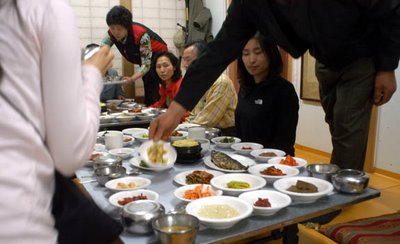
The bus-driver got us home in record time, according to Mr. Yi. I spent the entirety of the return journey snuggled up with my iPod and a book. We disembarked at 10:30. Na-ri's father gave each staff member a five-kilo box of sweet yams to take home, and it took all my remaining strength to lug the box of starch 100 yards to the taxi stand.
Like I said before, bus tours suck because one doesn't have the time to properly explore the amazing places where the bus stops. To my mind, the best part of the trip wasn't the stops or even the amazing food, it was getting to know my fellow teachers outside of work.
Within ESS, the Korean teachers are friendly, but focused on the task at hand. My communication with them is usually limited to talking about classes and helping them understand or pronounce difficult English idioms, phrases and words. They wear pressed suits, black slacks and meticulously manage their makeup. When I come back from a series of classes, I am covered in chalk dust as if I just got attacked with a chalk-grenade and the Korean teachers still look like the partners in a major Korean law firm.
On the bus, at the stops, and in the restaurants, it was like I was hanging out with the Korean teacher's alter-egos. Like I said earlier, the ladies wore jeans, t-shirts and tennis shoes. They giggled like little girls, held hands and joked with Gavin and I. They cut up at the restaurants and enjoyed themselves, and I enjoyed being a part of their group. I felt less like a stranger in a strange land. This was one of the experiences I was looking for when I came to Korea.
Well, that's all I have for you this time. Here are a few more photos from the week.

Gavin and I spent Sunday in Haeundae. This was taken at the APEC island.
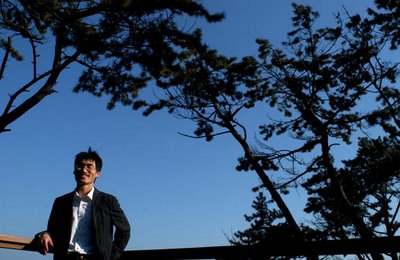
A mirror salesman in Nampo-dong.
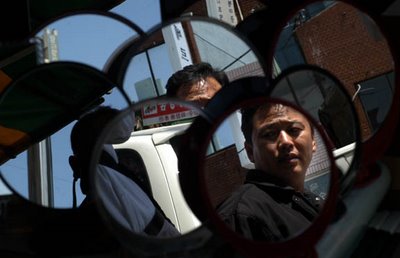
Old guy on the boardwalk in Haeundae.
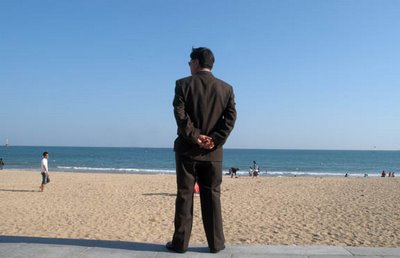
No Korean Files this week, as I am building case for the next update. I hope everyone is doing well, and please take the time to check out my website. The URL again is as follows:
www.notesjones.com
2 comments:
hi,it's me again!
Did you enjoy the trip to Hae-nam!
You also felt the lack of staying less time in the great places. me, too. because of the time limit, Mr. kim did it.. i was sorry, too.
but the places and food were really great, weren't they?? and i am proud of you knowing the history of Korea.. thank you!!
but you didn't mention me.!! you memtioned the other teachers(about clothes, feelings, talks...etc) exceopt me!! i am angry!!!!! really angry!!! i am kiddng, you know. good night stephen!
Wow... this blog has some awesome pictures. Outstanding commentary/pictures. Thanks for sharing.
Post a Comment